
The cinnabar moth is a brightly coloured arctiid moth found as a native species in Europe and western and central Asia then east across the Palearctic to Siberia to China. It has been introduced into New Zealand, Australia and North America to control ragwort, on which its larvae feed. The moth is named after the red mineral cinnabar because of the red patches on its predominantly black wings. The species was first described by Carl Linnaeus in his 1758 10th edition of Systema Naturae. Cinnabar moths are about 20 mm (0.79 in) long and have a wingspan of 32–42 mm (1.3–1.7 in).

Eacles imperialis, the imperial moth, is a Nearctic member of the family Saturniidae and subfamily Ceratocampinae. The species was first described by Dru Drury in 1773.
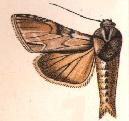
Cucullia lilacina is a moth of the family Noctuidae. It is found in Mexico and the south-western United States. In the United States, it is found in the mountains of southern Arizona, reaching as far north as the White Mountains in the east and the Grand Canyon in the west. It is also present in most of New Mexico and in western Texas. In Mexico it has been recorded from the Federal District and Veracruz. A single female is known from Juan Vinas in central Costa Rica.

Lantanophaga pusillidactyla, the lantana plume moth, is a moth of the family Pterophoridae. It is native to the southern United States, Mexico, the Caribbean, and South America. It was introduced to Australia accidentally in 1936 and is now found from Sydney to Cairns along the coast. It has also been introduced to Hawaii in 1902, Pohnpei in 1948, and Palau in 1960 for biological control. It has since been recorded from Yap in 1987–1988 and is now distributed on all islands of the Mariana and Caroline Islands where the host plant is found, except Aguijan.
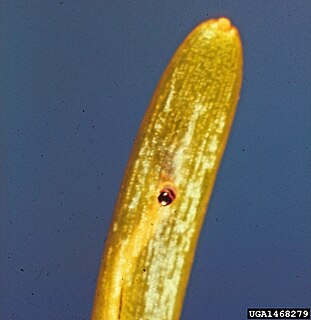
Epinotia meritana, the white-fir needle miner, is a moth of the family Tortricidae. It is found in the western United States, including Utah, New Mexico and Arizona.
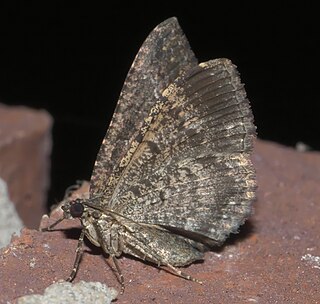
Disclisioprocta stellata, the somber carpet or bougainvillea looper, is a moth of the family Geometridae. It is found in sub-Saharan Africa, the islands of the Indian Ocean, and from eastern Canada south through the United States, Mexico, the Antilles, Bahamas and Bermuda Islands to Bolivia and Brazil. It was introduced to Hawaii in 1993.

Crocidosema lantana, the lantana flower-cluster moth or lantana tortricid moth, is a moth of the family Tortricidae. It was first described by August Busck in 1910. It is native to Mexico and the southern United States, but was introduced to Hawaii in 1902, Australia in 1914 and the Caroline Islands in 1948 and 1949 to aid in the control of Lantana weeds. It has also been recorded from Yunnan, China and in Sri Lanka.

Platynota rostrana, the omnivorous platynota moth, is a species of moth of the family Tortricidae. It is found from the United States, south through Mexico and Central America to South America. Its native range also includes the West Indies. It has been recorded from Europe, where it may temporarily establish through accidental importation in tropical plants.
Comadia bertholdi, the lupine borer moth, is a moth in the family Cossidae. It is found in the United States, where it has been recorded from Washington, Colorado, Wyoming, Arizona, California, Nevada and New Mexico.

Givira lotta, the pine carpenterworm moth, is a moth in the family Cossidae. The species was first described by William Barnes and James Halliday McDunnough in 1910. It is found in the United States, where it has been recorded from California, Arizona, New Mexico and Colorado. The habitat consists of pine forests.
Petrophila schaefferalis is a moth in the family Crambidae. It was described by Harrison Gray Dyar Jr. in 1906. It is found in Mexico (Xalapa) and the southern United States, where it has been recorded from Arizona, California and Texas.
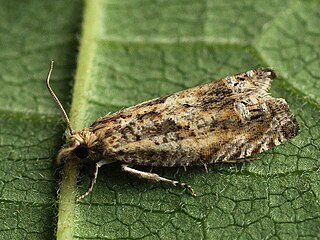
Eucosma aemulana, the obscure bell, is a species of moth of the family Tortricidae. It is found in China, Korea, Russia and most of Europe. It is also found in the United States, where it has been recorded from Colorado, New Mexico, Oklahoma and Utah. The habitat consists of woodlands, chalk downland and cliffs.
Trischistognatha pyrenealis is a moth in the family Crambidae. It was described by Francis Walker in 1859. It is found in Mexico, Central America, the West Indies and the southeastern United States, where it has been recorded from Georgia to Florida and from Alabama to Texas.
Rhectocraspeda periusalis, the eggplant webworm moth, is a moth in the family Crambidae. It was described by Francis Walker in 1859. It is found in the West Indies and from the United States, where it has been recorded from Florida, North Carolina, Ohio, Oklahoma, South Carolina and Tennessee, south through Mexico and Central America to South America, including Ecuador, Brazil, Guyana, Trinidad and Tobago and Suriname.

Lacinipolia laudabilis, the laudable arches moth, is a moth of the family Noctuidae. It is found in the United States, where it has been recorded from Alabama, California, Florida, Georgia, Kentucky, Maryland, North Carolina, Oklahoma, Massachusetts, Pennsylvania, South Carolina, Tennessee, Texas and Virginia. It is also found in Mexico and Costa Rica. It has been recorded from Great Britain, where it was probably accidentally imported, but it might also be a rare immigrant.

Prays atomocella, the hop-tree ermine moth, is a moth of the family Plutellidae. It is found in the United States, where it has been recorded from Arkansas, Illinois, Indiana, Kentucky, Michigan, New Mexico, Ohio, Tennessee and Texas.

Lineodes fontella, the eastern lineodes moth, is a moth in the family Crambidae. It was described by Walsingham in 1913. It is found in the United States, where it has been recorded from Florida, North Carolina, South Carolina and Texas. Outside of the States, it is found in Jamaica, Cuba, the Dominican Republic, Mexico, Panama, Guatemala, Honduras, Brazil, French Guiana and Guyana.
Loxomorpha flavidissimalis is a moth in the family Crambidae. It was described by Augustus Radcliffe Grote in 1877. It is found in the United States, where it has been recorded from Texas, Florida, North Carolina and West Virginia. It is also found in Mexico and Puerto Rico. It has also been recorded from Australia.
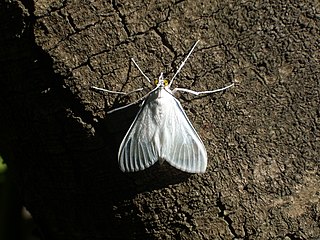
Palpita flegia, the satin white moth, is a moth in the family Crambidae. It was described by Pieter Cramer in 1777. It is found in Suriname, Colombia, Brazil, Honduras, Nicaragua, Costa Rica, Panama, Mexico, the Caribbean and the United States, where it has been recorded from Alabama, Florida and Texas.
Keiferia glochinella, the eggplant leafminer moth, is a moth in the family Gelechiidae. It was described by Zeller in 1873. It is found in the United States, where it has been recorded from Texas, New Mexico and California. Records outside the western United States are based on misidentifications.












